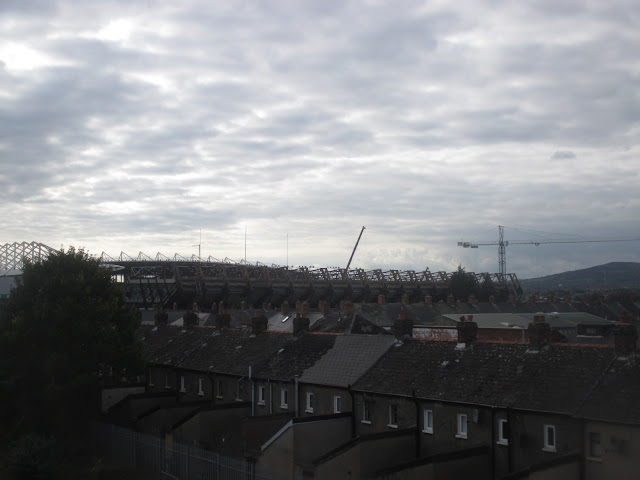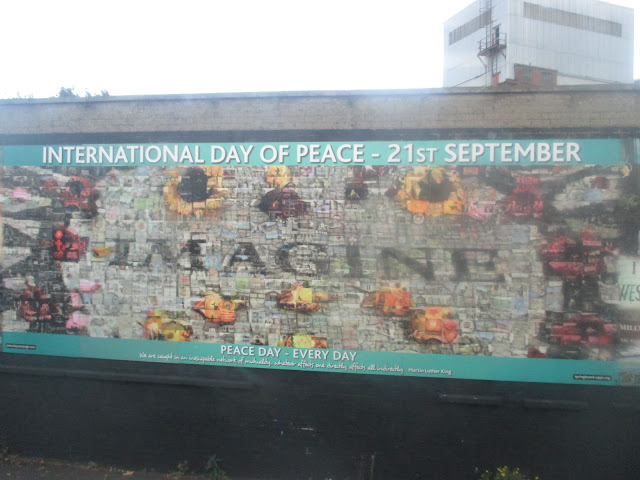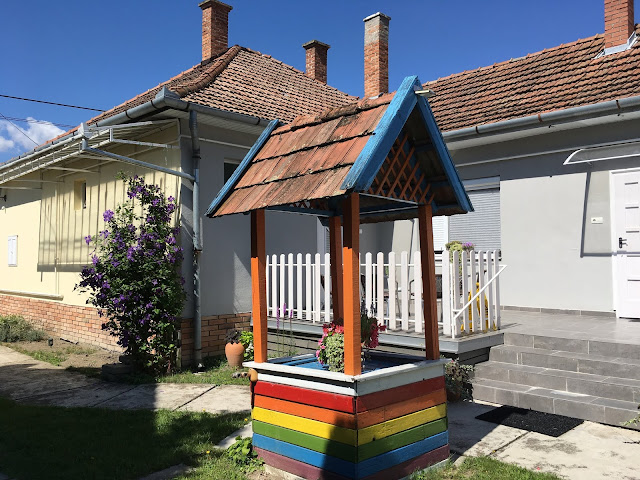Finally I got the chance to get back to blogging properly! We are currently in Gyula, Hungary, and pretty much everything is set for the USA, too, so right now I'm trying to concentrate on getting this blog up to date. This is the second part of our trip to Ireland and Northern Ireland - if you missed out on the Dublin entry, it's
right here.
Anyway, I'd been wanting to go to Northern Ireland for a longer time. I've read a lot about the Troubles and just felt this need to experience the place with a history like that - you know, to really feel the atmosphere of Belfast. Obviously it's not just Belfast that has been through some severely violent times, but with just a couple of days, we figured it would be better to concentrate on one city. Also, I would like to point out that this post is only about my experiences travelling in Belfast and my intention is not to insult anyone. We visited the most troubled areas of the Troubles - the Falls Road and the Shankill Road - so I will be writing something about how it felt to be there.
Anyway, we caught an early morning train from Dublin to Belfast. It's not a particularly long trip, just 2,5 hours, but the tickets were quite expensive. I'd maybe suggest looking into Dublin Coach for cheaper tickets.We stayed at
Belfast International Youth Hostel on Donegall Road, which was a brilliant choice as the double rooms are basically proper hotel rooms. The hostel is within a short walk from the city centre of Belfast and it has its own coffee shop/restaurant called Causeway Cafe as well as a Tour Office where you can easily book day trips to the Giant's Causeway. We were really pleased with the hostel! We technically had three days in Belfast but decided to spend one of them on a tour along the Causeway Coastal Route all the way to the Giant's Causeway. I'll write a separate post on the tour, so this entry is about our two days in Belfast.

I have to say that I loved Belfast the minute I got off the train. There's something about that city that feels like me - it's a little bit miserable, but at the same time really trying its best to be cheerful just like everyone else. The weather matched this atmosphere, too - a little bit of sunshine with a little bit of drizzle on the side. Loved it! Belfast shot up to my top favourite cities easily!
 |
| The view from our hostel window. |
There were two things that I especially wanted to experience in Belfast - the many political murals and the general vibe the Troubles have left the city with, and Titanic Belfast, a museum dedicated to the ship that was built in Belfast. Both of these are topics that have always interested me immensely, and I have consumed countless books and documentaries on both.
As we only had two days, we decided to go for the Hop On Hop Off bus to save time trying to figure out the local buses. Some of the sights are a bit further away, too, such as Titanic Belfast and Stormont, or the Parliament Buildings, so the bus came in handy in that respect, too. Also, the bus takes you through the Falls Road and the Shankill Road with a pretty good commentary on the topic. Therefore, no matter how touristic those buses might be, sometimes I really vote for them. The guides were excellent, too! The ticket is valid for 48 hours so you have quite a lot of time to visit places.
Day 1
So, on our first day, we went for a full bus tour of the city without any stops along the way, at the same time the main destination being the Falls and Shankill Road area.
 |
| Titanic Belfast. The building is in the shape of a star to commemorate the shipping company White Star Line. |
 |
| Stormont. |
 |
| The Beacon of Hope statue. |
 |
| The Europa Hotel. It was bombed 36 times during the Troubles and is known as the most bombed hotel in Europe and in the world. |
 |
| Queen's University. |

Before the Falls and Shankill Road pictures, I want to say a couple of things about the Troubles. It is quite common to hear that the Troubles were a conflict between the Catholics and the Protestants in Northern Ireland. However, more than that, the Troubles were a nationalist conflict - on the one hand, the loyalists/Unionists wanted to belong to the UK while on the other the republicans/Nationalists wanted to belong to the Republic of Ireland. Both parties had their own paramilitary forces - the IRA and the INLA on the republican side and the UVF and UDA on the loyalist side, and the British Army was present, too. While there were bombings and other acts of violence happening all over Belfast as well as other locations in Northern Ireland, the neighbouring, mostly working class suburbs of the Falls and Shankill Road were the most problematic areas. These two suburbs are right next to each other but separated by so called Peace Walls, which were (and mostly still are) there to literally keep the peace. The Peace Wall that we saw was very tall to prevent anything from being thrown across it, and while during the day the bus could drive pretty freely through the areas, the wall is locked for the night for safety reasons. It's very peculiar to say the least to see arrangements like that in modern day Europe and to understand that they might actually still serve a purpose.
As you get closer, you'll start noticing (illegal) Ulster flags flying on the lampposts to indicate the political preferences of the area in question. The Ulster flag, of course, symbolises loyalism to the UK, Ulster being the Unionists' preferred name for Northern Ireland. Ulster is also one of the provinces in Northern Ireland, but the name has political connotations as well.
 |
| The RISE sculpture symbolises a new chapter in the history of Belfast. |
First up, I have pictures from the Falls Road, the Catholic and Nationalist suburb.
 |
| A bombed building. |
 |
| A mural of Bobby Sands, an IRA member who starved himself to death while imprisoned in 1981. |
 |
| The International Peace Wall. |
 |
| The Peace Wall dividing the Falls Road and the Shankill Road in the distance. |
 |
| The Peace Wall. |
 |
| A general view. |
 |
| Welcome to Shankill Road. |
 |
| A mural dedicated to the Queen. |
Going through these two roads was one of the most interesting experiences I've ever had on a trip. It was something I'd never seen anywhere before - the murals are everywhere, the politics is everywhere, and bombed down buildings are everywhere. It's a different world altogether. If you're interested in reading, I can recommend you a couple of writers. Eimear O'Callaghan has published a book called
Belfast Days: A 1972 Teenage Diary, which will give you quite a good view of what it was like to be a 16-year-old Catholic girl in the Falls Road during the Troubles. Tony Macaulay, on the other hand, has written several memoirs about growing up in the Troubles from the point of view of a Protestant schoolboy. The first book in the series is called
Paperboy - highly recommended!
Anyway, next we were in need of some food, so we headed to Victoria Square Shopping Centre for some Frankie and Benny's. The shopping centre also has quite a good viewing platform in its Dome, which is exactly where we went after eating. The rest of the afternoon and evening was spent wandering around in the streets of Belfast.
 |
| The Albert Memorial Clock clock tower. |
 |
| Customs House. |
 |
| The Big Fish in Donegall Quay. |
 |
| Some details... |
 |
| The City Hall. |
 |
| The Titanic Memorial in front of Belfast City Hall. |
 |
| Grand Opera House. |
 |
| The Crown Liquor Saloon, one of the most well-known pubs in Northern Ireland. |
 |
| A Titanic mural next to our hostel. |
 |
| Some other murals next to our hostel. |
 |
| Belfast by night - the view from our room facing the direction of the Falls and the Shankill Roads. |
Day 2
On our second day, we went to Titanic Belfast. First, however, we had an Ulster Fry each. Mine's a veggie one while Julcsi's version is the original version with the meat included:
Very nice! The different types of bread are so, so, so good!!!
 |
| On our way to the bus, we discovered a pub with an excellent name :D! |
Titanic Belfast costs £18 and for that price, you'll experience an excellent exhibition on the Titanic's history, from the building process to the ports of call to the cabins to the passengers, all the way to the sinking of the ship. In addition, you get to visit SS Nomadic, a White Star Line tender boat that transferred passengers to and from the Titanic. I couldn't recommend this place more, it's a must for anyone interested in the history of Titanic!
 |
| Titanic was here. |
 |
| A first class cabin. |
 |
| A third class cabin. |
 |
| Deck games - Shuffleboard. |
SS Nomadic was a nice bonus, too. At least for me it was interesting to be on the vessel that carried actual passengers to Titanic...
 |
| Titanic is visible in Belfast in many ways... |
Our second destination of the day was
Crumlin Road Gaol, which is where many of the political prisoners related to the Troubles were imprisoned. You can go on a very informative guided tour and find out more about the prisoners who managed to escape, punishment methods, and the executions that took place there, for example.
 |
| There was a direct tunnel between the prison and the courthouse opposite it on the other side of the road. Nowadays it's not possible to go through the tunnel but you can still walk there to get a feeling of what it was like for the prisoners to be escorted from the prison to the courthouse. |
 |
| The courthouse - not in use anymore, however. |
And this is basically it from Belfast. For some amazing scenery, stay tuned for the update on the Giant's Causeway tour!












































































































Extremely interesting, thanks for sharing all this:)
ReplyDeleteBF3520CB9B
ReplyDeletehacker bulma
hacker arıyorum
tütün dünyası
-
-